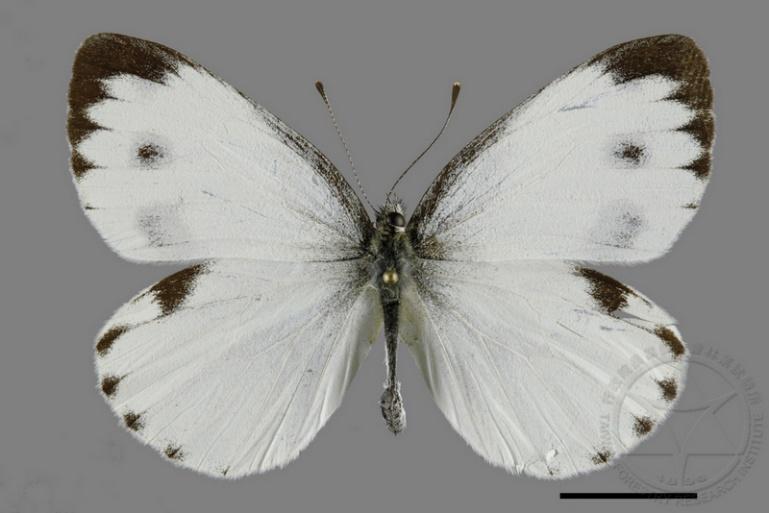The ugly duckling becomes a beautiful swan In campuses‚ parks or wherever there is Pilose Beggartick [1] and Oriental Hawksbeard [2] growing there’s a good chance that the Indian Cabbage White (Pieris canidia) butterfly will be seen. Below the appearance of the Indian Cabbage White at the egg‚ larva‚ pup and adult stages is described: Egg: The Indian Cabbage White is in Family Pieridae; its eggs are pale yellow and artillery shell shaped.
Larva: The larva have blue-green bodies and are covered in fine hairs. They mainly eat Brassicaceae vegetables such as Chinese cabbage and cabbage or Liodendron formosanum in family Euphorbiaceae.
Pupa: the cocoon is green or brown and is fixed to an object by silk threat.
Adult: The adults fly quite slowly and also quite low; they like to gather together to drink water. The males and female look similar but the black scales on the wings of the female are more developed than those of the male.

The Indian Cabbage White has a wide range and can be seen all over Taiwan.
(Image source: Taiwan Forestry Research Institute‚ Insect Collection of Taiwan Forestry Research Institute)
What is di huang (Rehmannia glutinosa)?
Rehmannia glutinosa is a perennial herb in family Scrophulariaceae and its roots are a traditional Chinese medicine. The often-mentioned Six Flavor Rehmannia Pills [3] are one of the basic prescriptions in Chinese medicine. The origin of the name di huang (Rehmannia glutinosa) is mentioned in both Shennong's Classic of Materia Medica [4] and the Compendium of Materia Medica. The climate and soil of Taiwan are not suitable for growing it so most of the Rehmannia glutinosa sold in Taiwan comes from Henan Province in China. Rehmannia glutinosa differs in appearance and effect depending on how it is prepared. The three main types of Rehmannia glutinosa are:
Raw Rehmannia glutinosa: after picking the stem‚ leaves and fibrous roots are removed.
Dried Rehmannia glutinosa : it is sun-dried after picking.
Cooked Rehmannia glutinosa: raw Rehmannia glutinosa is steamed after mixing it with wine and Fructus amomi [5] ; after being steamed until well done it is then sun-dried.
In terms of nature and taste‚ raw Rehmannia glutinosa is “cold” and bitter sweet‚ and has a cooling effect and stimulates saliva production; dried Rehmannia glutinosa is sweet and has a heat dissipation and blood cooling effect; cooked Rehmannia glutinosa is warm and sweet‚ nourishes the yin and strengthens the blood. As well as being made into Chinese medicine and being mixed with other Chinese medicinal herbs‚ Rehmannia glutinosa can also be used in cooking‚ to boil eggs‚ stew chicken or make wine. Rehmannia glutinosa juice is the juice of raw Rehmannia glutinosa (can add lily) that has been boiled; it is effective for nourishing the yin and dissipating heat [6] .
When the Chinese mesona blooms
Chinese mesona (Mesona chinensis) is an annual herb in Family Lamiaceae. It has oblong leaves which are covered with fine hairs. It blooms in autumn. The light purple flowers have racemes [7] made up of umbels [8] and have an unusual appearance. Guanxi Township in Hsinchu County is one of the main production centers for Chinese mesona in Taiwan; the harvest takes place in September-October. The plants are harvested before they bloom and then a series of sun-drying stages follow. The dried Chinese mesona is then simmered over a low heat and becomes highly aromatic Chinese mesona juice.
When they hear the name Chinese mesona many people will think of the cooling green grass tea or herbal jelly of summer. Actually‚ as well as being made into drinks and snacks loved by many‚ Chinese mesona is also used as Chinese medicine and has a het clearing and cooling effect. Occasionally hawkers can be seen selling dried Chinese mesona from small trucks by the roadside‚ bringing back nostalgic memories for many people.

A large quantity of Chinese mesona is grown in Guanxi‚ Hsinchu County and it is renowned for its quality.
(Image source: Hakka Affairs Council)
1. Pilose Beggarticks (Bidens pilosa var. radiata)‚ also called “ghost needle grass” and is a perennial herb. Its flowers are white and petals tongue shaped. The black fruit has a needle-shaped crest. The whole plant is one of the ingredients for “green grass tea” (Chinese herbal tea).
2. Oriental Hawksbeard (Youngia japonica) is an annual or biennial herb. The yellow flowers are made up of tongue shaped petals. When ripe‚ the fruit is carried all around by the white crest in the wind.
3. Six Flavor Rehmannia Pills (liu wei di huang wan): these are made from cooked Rehmannia glutinosa (di huang)‚ Medical Dogwood (shan zhu yu)‚ Chinaroot Greenbrier Rhizome (fu ling)‚ Chinese yam (shan yao)‚ Tree peony bark and the Alisma plantago-aquatica (zhe xie). They nourish the yin and strengthen the kidneys.
4. Shennong's Classic of Materia Medica (shen nong ben cao jing): Is the earliest known Chinese medicine book.
5. Fructus amomi (sha ren): a kind of Chinese medicine; it boosts energy‚ strengthens the lungs and invigorates the spleen.
6. Lily and Rehmannia glutinosa soup (bei he di huang tang): From the Eastern Han Dynasty book Jin Gui Yao Lue (Synopsis of Golden Chamber) by Zhang Zhong-Jing.
7. Raceme: the flowers have small pedicels and are arranged on the small stems of the branches.
8. Umbel: equal in length to the pedicel‚ they are borne on the top of the pedicel‚ arranged in umbrella shape.
|